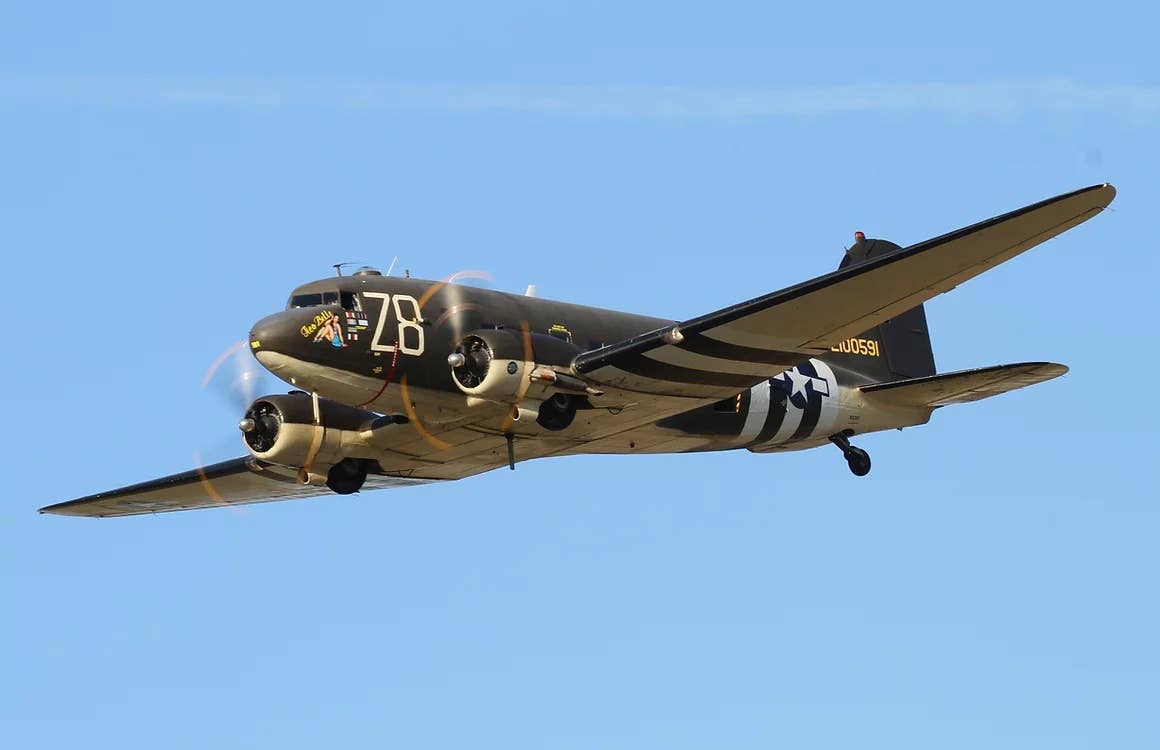The Douglas C-47: A Christmas Story
December 17, 1935, saw the first flight of the Douglas Sleeper Transport, or DST, which marked the first variant of the DC-3 series. One last major offensive in World War II is worth reflection upon the anniversary of the DC-3’s first flight.

The Douglas C-47, a variant of the DC-3, factored heavily into the Allies’ success in fighting the Battle of the Bulge. [Courtesy of the Museum of the U.S. Air Force]
For those who follow the history of the Douglas DC-3, the date December 17 carries a significance beyond its connection to the Wright Brothers’ first flight in 1903.
That’s because—just over three decades later in 1935—the auspicious date saw the first flight of the Douglas Sleeper Transport, or DST, which marked the first variant of the DC-3 series.
When the final DST configuration was settled on and the first model ready for flight, it was a cool, clear day in December. Coincidentally, it was the 32nd anniversary of the Wrights’ famous flight: December 17. In the late afternoon, around 3 p.m., the airplane rolled out, but this time the flight wasn’t turned into a company lunch break or notable event, and even few of the Douglas executives took the time out to watch. It’s assumed that Doug did, but no photo remains of the occasion (if one was ever taken) and no specific notes remain on the particular flight. [Douglas chief pilot Carl] Cover’s logbook entry is simple, as though he was just testing another DC-2 off the line.
In a sense, he was—there was little in the way of dramatic leaps in technology or performance from the DC-1 to the DST, as Doug would note later on, yet it was almost a totally new airplane from a parts standpoint. Much of the change needed to stretch and widen the airplane resulted in similar but improved handling characteristics. What Cover may have noticed were the improvements to ergonomics in the cockpit, and, as the testing went on, the more luxurious interior on the DST, required by the purpose it served as a sleeper transport and not just a day plane.
—excerpt from “Honest Vision: The Donald Douglas Story”
A Key to Winning the War
Just a few years later, the DC-3’s military versions—beginning with the C-47—would prove pivotal in World War II. The capable and forgiving twin would keep its crews safe with the numerous improvements integrated into its systems and performance, while they delivered load after load of troops and cargo across oceans and to the front lines, particularly in the European Theater.
As a result of the massive mobilization of aircraft manufacturing in the wake of the establishment of the industry-led War Production Board in January 1942, the Allied Forces had the “Arsenal of Democracy,” which exceeded the 50,000 aircraft touted by President Franklin Delano Roosevelt as an outline of the production effort.
The D-Day Squadron will honor the missions flown around the Normandy Invasion when it returns to those shores in May and June 2024—but also lend to its audience and participants the sense of what other massive operations would feel like witnessing from the air and on the ground. While several aircraft flying over from the U.S. participated in the commemorative occasion on the 75th anniversary of D-Day in 2019, at least one new entrant hopes to be flying in time: the C-47 'Night Fright'.
READ MORE: To Honor and Remember: D-Day
After D-Day
The Normandy Invasion marked a turning point in the war—and following the strikes in June 1944, it seemed that it would be nearing its end in Europe. But a few critical events remained.
One would begin on the eve of the airplane’s 9th anniversary. On December 16, 1944, the German war machine launched one last large-scale offensive, amassing more than a million soldiers along a 75-mile front.
The Battle of the Bulge—known then as the Ardennes Offensive, as it spanned the Ardennes Forest along the German-Belgian border—caught the Allied forces by surprise, but they quickly mobilized a counter attack that once again hinged on the utilization of the C-47 fleets. Fighting the severe cold over the course of six weeks, more than a million Allied troops, including the 101st Airborne Division, brought their full force to bear. Defending the town of Bastogne, beginning on December 22, over the course of the next several days, “961 C-47s and 61 gliders dropped 850 tons of supplies and ammunition to Bastogne,” according to the RAF Mildenhall website.
To talk with the troops on the ground, those supplies proved not only critical from a logistical sense, but also in terms of morale. The pilots I spoke with while gathering stories for "Together We Fly: Voices From the DC-3" recalled the bitter cold—and the fact the brunt of the fighting took place over Christmas. Feeling far from home at a poignant time, soldiers witnessed the sight of one hundred C-47s at a time overhead, visible through the clearing skies.
So on this anniversary of the Wright Flyer’s first success, and that of the DC-3’s inaugural test flight, I think of those soldiers and count my blessings this holiday season.
Editor’s Note: You can win a flight in a DC-3 and a history package from the D-Day Squadron by entering here.

Subscribe to Our Newsletter
Get the latest FLYING stories delivered directly to your inbox






